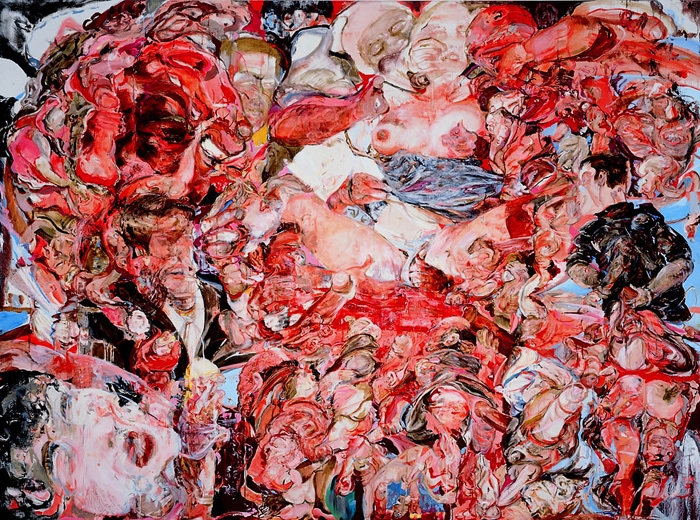Cecily Brown is an artist known for her abstract expressionist paintings. In these works, Brown generously applies oil paint to huge canvasses, creating a sense of movement and depth. Her glossy varnish over richly applied paint creates visceral images. Brown expanded the figurative abstraction painting genre, which had previously been dominated by male painters like Willem de Kooning and Francis Bacon. Many of her paintings have sexually explicit themes, with her latter works’ images more subtly suggested.
In an interview, Brown said she was conflicted about making female nudes but thought her (conflicted) feelings showed in her paintings. She doesn’t really consider them nudes because “they feel melancholic, for the most part . . . not titillating.” In contrast, her abstract expressionist (mostly male) predecessors’ works have been described as objectifying women. The Art Story says, “(her) lavishness itself is expressive, unsettling, and visceral . . . (Brown) mocks sexuality with equal parts sensuality and repulsion.”
Both of Brown’s parents encouraged her to become an artist. Her art critic father introduced her to painter Francis Bacon, who remains a constant influence. After graduating from London’s Slade School of Fine Art in 1993, she moved to New York City to start her career. She experienced the stereotypical starving artist lifestyle of working in a restaurant, eating cheaply, and spending her free time creating paintings. Fairly quickly, she was signed by one of the world’s most prestigious galleries, the Gagosian. According to art historian Peter Kalb, “the breadth of Brown’s references and the assertive manner in which she makes them her own turned her work into statements of a late (20th) century feminist art.”

Puce Moment
http://www.saatchigallery.com/artists/cecily_brown.htm
Puce Moment (1997) is an image of excess. Numerous human figures are sprawled across the large painting. This piece is typical of the artist’s early work because it is crowded with partly abstract fragments of body parts, in dramatic reds and pinks. References to de Kooning and Bacon can be seen in Brown’s figurative abstraction and assertive brushwork. However, Brown challenges the “traditional male gaze” in depicting female nudes. According to the Saatchi Gallery, her images are not of women to be possessed by the male gaze; the female images (like the males’) are “mounds of flesh, parts assembled in a confusing hodgepodge in which male and female are indistinguishable from one another . . . In such a context, the gaze itself becomes repulsive and the possibility of possession is thwarted” (Saatchi).

Night Passage
http://www.saatchigallery.com/artists/cecily_brown.htm
Brown’s 1999 Night Passage is a large (approximately 8 foot by 9 foot) lushly painted image of an intimate couple. It contains elements of other famous painters: pastel colors from Monet’s water lilies, imagery similar to O’Keeffe’s flowers, and bold brush strokes of macho abstract painters like de Kooning. Yet, Brown makes the image distinctly her own.

Aujourd’hui Rose
https://theartstack.com/artist/cecily-brown/aujourd-hui-rose-2005
Aujourd’hui Rose (2005) is another large (about 6 foot by 4.5 foot) painting with elements of famous artists represented. It is of the “Vanitas” genre, which was popular with 17th century Flemish painters. This style of still life painting used symbols of death (often a skull) along with images of the vanity and transience of earthly pleasures. Also, the two Victorian-era girls in Degas’ “ballerina” pink, playing with a puppy, are reminiscent of impressionist paintings of realistic scenes of life (as opposed to composed studio portraits). The viewer shifts from the image of a skull to focusing on the children enjoying the dog. The placement of the sweet children within the skull provides a thought-provoking contrast of images.
For a sampling of Brown’s work and influences, and an interview with the artist, check out this Louisiana Channel video: http://channel.louisiana.dk/video/cecily-brown-take-no-prisoners.
Cecily Brown’s art attracts viewers with its “painterly” references to other great artists, as well as her own intriguing figurative abstraction. Brown describes that, “I have always wanted to make paintings that are impossible to walk past, paintings that grab and hold your attention. The more you look at them, the more satisfying they become for the viewer. The more time you give the painting, the more you get back.” Brown honors her craft’s past while propelling it into the future.
Sources:
Art Stack. “Aujourd’hui Rose by Cecily Brown.” theartstack.com.
https://theartstack.com/artist/cecily-brown/aujourd-hui-rose-2005
Kalb, Peter R. Art Since 1980, Charting the Contemporary. Pearson. New York. 2014. p. 253-4.
Louisiana Channel. “Cecily Brown, Take No Prisoners.” . Channel.louisiana.dk. http://channel.louisiana.dk/video/cecily-brown-take-no-prisoners
Saatchi Gallery. “Cecily Brown.” saatchigallery.com. http://www.saatchigallery.com/artists/cecily_brown.htm
The Art Story/Modern Art Insight. “Cecily Brown.” theartstory.com. http://www.theartstory.org/artist-brown-cecily.htm
Zhong, Fan. “Five Minutes with Cecily Brown.” W Magazine. 7 May 2013. http://www.wmagazine.com/story/cecily-brown-gagosian-solo-exhibition